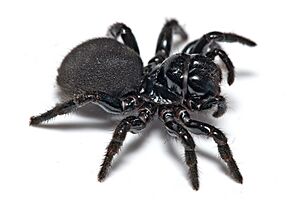Missulena facts for kids
Quick facts for kids Missulena |
|
|---|---|
 |
|
| Male Missulena occatoria | |
| Scientific classification |
|
| Kingdom: | Animalia |
| Phylum: | Arthropoda |
| Subphylum: | Chelicerata |
| Class: | Arachnida |
| Order: | Araneae |
| Infraorder: | Mygalomorphae |
| Family: | Actinopodidae |
| Genus: | Missulena Walckenaer, 1805 |
| Type species | |
| M. occatoria Walckenaer, 1805 |
|
| Species | |
|
18, see text |
|
Missulena is a group of spiders often called mouse spiders. They belong to a family of spiders known as Actinopodidae. These spiders were first described in 1805 by Charles Athanase Walckenaer.
Most mouse spiders live in Australia. However, one species, M. tussulena, is found in Chile. The name "mouse spider" comes from an old idea that they dug burrows like mice. This idea has since been proven wrong. Another spider, Scotophaeus blackwalli, is also called a "mouse spider." But it is much smaller and not related to the Missulena spiders.
Contents
What Do Mouse Spiders Look Like?
Mouse spiders are medium to large in size. They can be anywhere from 1 cm to 3 cm long. Their top shell, called a carapace, is shiny. They have high, wide heads with eyes spread across the front.
Their spinnerets, which make silk, are short. They are located at the back of their abdomen. Male and female mouse spiders look different. This is called sexual dimorphism. Female spiders are all black. Male spiders have special colors for their species.
For example, the male eastern mouse spider (M. bradleyi) has a blue patch. The male red-headed mouse spider (M. occatoria) is brownish or blue-black. It also has bright red jaws.
What Do Mouse Spiders Eat?
Mouse spiders mainly prey on insects. They might also eat other small animals if they get the chance. The main animals that hunt mouse spiders are wasps, centipedes, and scorpions.
Where Do Mouse Spiders Live?
Mouse spiders are found in areas that were once part of the ancient supercontinent Gondwana. Most species live across Australia. One species lives in Chile. Other spiders related to them are found in South America.
These spiders live in burrows in the ground. Their burrows are covered with trapdoors. These homes can go almost 30 cm (1 ft) deep. Female mouse spiders usually stay in their burrows. Male spiders, however, wander around looking for mates.
Are Mouse Spider Bites Dangerous?
Mouse spider bites can be painful. However, serious bites are quite rare. Most bites recorded in medical reports did not need special medicine or cause serious problems.
It is important to know that mouse spiders can look like dangerous Australian funnel-web spiders. Because of this, any bite from a spider that looks like a mouse spider should be checked by a doctor. The venom of the eastern mouse spider (M. bradleyi) has toxins similar to those found in funnel-web spider venom.
Good news! The medicine used for funnel-web spider bites, called antivenom, works for serious mouse spider bites too. Unlike funnel-web spiders, mouse spiders are not very aggressive towards people. They often give "dry" bites, meaning they don't inject venom.
Even though some evidence suggests their bites could be serious, recorded bites are uncommon. This is true even though some mouse spider species live near people. Funnel-web antivenom is an effective treatment for serious bites.
Species of Mouse Spiders
As of 2019, there are 18 known species of mouse spiders.
- Missulena bradleyi Rainbow, 1914—Australia (New South Wales)
- Missulena dipsaca Faulder, 1995—Australia
- Missulena faulderi Harms & Framenau, 2013—Australia (Western Australia)
- Missulena granulosa (O. Pickard-Cambridge, 1869)—Australia (Western Australia)
- Missulena harewoodi Framenau & Harms, 2017—Australia (Western Australia)
- Missulena hoggi Womersley, 1943—Australia (Western Australia)
- Missulena insignis (O. Pickard-Cambridge, 1877)—Australia
- Missulena langlandsi Harms & Framenau, 2013—Australia (Western Australia)
- Missulena leniae Miglio, Harms, Framenau & Harvey, 2014—Australia (Western Australia)
- Missulena mainae Miglio, Harms, Framenau & Harvey, 2014—Australia (Western Australia)
- Missulena melissae Miglio, Harms, Framenau & Harvey, 2014—Australia (Western Australia)
- Missulena occatoria Walckenaer, 1805—Southern Australia
- Missulena pinguipes Miglio, Harms, Framenau & Harvey, 2014—Australia (Western Australia)
- Missulena pruinosa Levitt-Gregg, 1966—Australia (Western Australia, Northern Territory)
- Missulena reflexa Rainbow & Pulleine, 1918—Australia (South Australia)
- Missulena rutraspina Faulder, 1995—Australia (Western Australia, South Australia, Victoria)
- Missulena torbayensis Main, 1996—Australia (Western Australia)
- Missulena tussulena Goloboff, 1994—Chile
See also
 In Spanish: Missulena para niños
In Spanish: Missulena para niños


